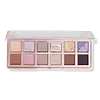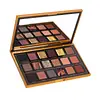What's inside
What's inside
 Key Ingredients
Key Ingredients

 Benefits
Benefits

 Concerns
Concerns

 Ingredients Side-by-side
Ingredients Side-by-side

Calcium Aluminum Borosilicate
Dimethicone
EmollientHydrogenated Polyisobutene
EmollientMica
Cosmetic ColorantMagnesium Stearate
Cosmetic ColorantSilica
AbrasivePolyethylene
AbrasivePentaerythrityl Tetraisostearate
EmollientPhenoxyethanol
PreservativeTin Oxide
AbrasiveCaprylyl Glycol
EmollientDiethylhexyl Syringylidenemalonate
Skin ProtectingCaprylic/Capric Triglyceride
MaskingCI 77891
Cosmetic ColorantCI 16035
Cosmetic ColorantCI 77499
Cosmetic ColorantCI 15985
Cosmetic ColorantSynthetic Fluorphlogopite
Magnesium Myristate
Triethoxycaprylylsilane
CI 77491
Cosmetic ColorantCI 15850
Cosmetic ColorantBoron Nitride
AbsorbentCI 45410
Cosmetic ColorantCI 77007
Cosmetic ColorantCI 77492
Cosmetic ColorantIsononyl Isononanoate
EmollientCera Microcristallina
Emulsion StabilisingBis-Diglyceryl Polyacyladipate-2
EmollientSynthetic Sapphire
Copernicia Cerifera Wax
Tocopheryl Acetate
AntioxidantCI 77000
Cosmetic ColorantDimethicone/Vinyl Dimethicone Crosspolymer
Skin ConditioningHelianthus Annuus Seed Oil
EmollientCarthamus Tinctorius Seed Oil
MaskingStyrene/Butadiene Copolymer
Silica Dimethyl Silylate
EmollientCalcium Aluminum Borosilicate, Dimethicone, Hydrogenated Polyisobutene, Mica, Magnesium Stearate, Silica, Polyethylene, Pentaerythrityl Tetraisostearate, Phenoxyethanol, Tin Oxide, Caprylyl Glycol, Diethylhexyl Syringylidenemalonate, Caprylic/Capric Triglyceride, CI 77891, CI 16035, CI 77499, CI 15985, Synthetic Fluorphlogopite, Magnesium Myristate, Triethoxycaprylylsilane, CI 77491, CI 15850, Boron Nitride, CI 45410, CI 77007, CI 77492, Isononyl Isononanoate, Cera Microcristallina, Bis-Diglyceryl Polyacyladipate-2, Synthetic Sapphire, Copernicia Cerifera Wax, Tocopheryl Acetate, CI 77000, Dimethicone/Vinyl Dimethicone Crosspolymer, Helianthus Annuus Seed Oil, Carthamus Tinctorius Seed Oil, Styrene/Butadiene Copolymer, Silica Dimethyl Silylate
Cocoglycerides
EmollientBis-Diglyceryl Polyacyladipate-2
EmollientSilica
AbrasiveMica
Cosmetic ColorantCopernicia Cerifera Wax
Vp/Eicosene Copolymer
Ricinus Communis Seed Oil
MaskingTribehenin
EmollientCaprylic/Capric Triglyceride
MaskingSucrose Acetate Isobutyrate
Cetyl Alcohol
EmollientSynthetic Beeswax
Emulsion StabilisingPentaerythrityl Tetra-Di-T-Butyl Hydroxyhydrocinnamate
AntioxidantSynthetic Fluorphlogopite
Calcium Sodium Borosilicate
Hydrogenated Ethylhexyl Olivate
EmollientDimethicone
EmollientC10-18 Triglycerides
EmollientOctyldodecanol
EmollientHydrogenated Vegetable Oil
EmollientPolyhydroxystearic Acid
EmulsifyingDodecane
PerfumingCoconut Alkanes
EmollientDisteardimonium Hectorite
StabilisingOctyldodecyl Stearoyl Stearate
EmollientEthylhexyl Polyhydroxystearate
EmollientHydrogenated Olive Oil Unsaponifiables
EmollientPropylene Carbonate
SolventPropanediol
SolventDecylene Glycol
Skin ConditioningNeopentyl Glycol Diethylhexanoate
Emollient1,2-Hexanediol
Skin ConditioningDimethicone/Vinyl Dimethicone Crosspolymer
Skin ConditioningSimmondsia Chinensis Seed Oil
EmollientCoco-Caprylate/Caprate
EmollientCaprylhydroxamic Acid
Calcium Aluminum Borosilicate
Tin Oxide
AbrasiveTalc
AbrasiveAluminum Starch Octenylsuccinate
AbsorbentZea Mays Starch
AbsorbentMagnesium Myristate
Cetearyl Ethylhexanoate
EmollientLauroyl Lysine
Skin ConditioningOryza Sativa Powder
Pentaerythrityl Tetraisostearate
EmollientButyrospermum Parkii Butter
Skin ConditioningMagnesium Stearate
Cosmetic ColorantPolybutene
Synthetic Wax
AbrasiveZinc Stearate
Cosmetic ColorantDiisostearyl Malate
EmollientStearyl Dimethicone
EmollientTrimethylsiloxysilicate
EmollientDibutyl Lauroyl Glutamide
Skin ConditioningDibutyl Ethylhexanoyl Glutamide
Skin ConditioningEthylhexylglycerin
Skin ConditioningHydrogenated Polyisobutene
EmollientEthylene/Propylene/Styrene Copolymer
Butylene/Ethylene/Styrene Copolymer
Hydrated Silica
AbrasivePhenylisopropyl Dimethicone
Skin ConditioningTriethylhexanoin
MaskingC30-45 Alkyl Dimethicone
Skin ConditioningCetyl PEG/PPG-10/1 Dimethicone
EmulsifyingSorbitan Sesquioleate
EmulsifyingDimethiconol
EmollientHelianthus Annuus Seed Oil
EmollientTocopherol
AntioxidantBeta-Sitosterol
Emulsion StabilisingSqualene
EmollientCI 16035
Cosmetic ColorantCI 19140
Cosmetic ColorantBlue 1 Lake
Cosmetic ColorantCI 75470
Cosmetic ColorantCI 77000
Cosmetic ColorantUltramarines
Copper Powder
AntimicrobialIron Oxides
CI 77742
Cosmetic ColorantTitanium Dioxide
Cosmetic ColorantCocoglycerides, Bis-Diglyceryl Polyacyladipate-2, Silica, Mica, Copernicia Cerifera Wax, Vp/Eicosene Copolymer, Ricinus Communis Seed Oil, Tribehenin, Caprylic/Capric Triglyceride, Sucrose Acetate Isobutyrate, Cetyl Alcohol, Synthetic Beeswax, Pentaerythrityl Tetra-Di-T-Butyl Hydroxyhydrocinnamate, Synthetic Fluorphlogopite, Calcium Sodium Borosilicate, Hydrogenated Ethylhexyl Olivate, Dimethicone, C10-18 Triglycerides, Octyldodecanol, Hydrogenated Vegetable Oil, Polyhydroxystearic Acid, Dodecane, Coconut Alkanes, Disteardimonium Hectorite, Octyldodecyl Stearoyl Stearate, Ethylhexyl Polyhydroxystearate, Hydrogenated Olive Oil Unsaponifiables, Propylene Carbonate, Propanediol, Decylene Glycol, Neopentyl Glycol Diethylhexanoate, 1,2-Hexanediol, Dimethicone/Vinyl Dimethicone Crosspolymer, Simmondsia Chinensis Seed Oil, Coco-Caprylate/Caprate, Caprylhydroxamic Acid, Calcium Aluminum Borosilicate, Tin Oxide, Talc, Aluminum Starch Octenylsuccinate, Zea Mays Starch, Magnesium Myristate, Cetearyl Ethylhexanoate, Lauroyl Lysine, Oryza Sativa Powder, Pentaerythrityl Tetraisostearate, Butyrospermum Parkii Butter, Magnesium Stearate, Polybutene, Synthetic Wax, Zinc Stearate, Diisostearyl Malate, Stearyl Dimethicone, Trimethylsiloxysilicate, Dibutyl Lauroyl Glutamide, Dibutyl Ethylhexanoyl Glutamide, Ethylhexylglycerin, Hydrogenated Polyisobutene, Ethylene/Propylene/Styrene Copolymer, Butylene/Ethylene/Styrene Copolymer, Hydrated Silica, Phenylisopropyl Dimethicone, Triethylhexanoin, C30-45 Alkyl Dimethicone, Cetyl PEG/PPG-10/1 Dimethicone, Sorbitan Sesquioleate, Dimethiconol, Helianthus Annuus Seed Oil, Tocopherol, Beta-Sitosterol, Squalene, CI 16035, CI 19140, Blue 1 Lake, CI 75470, CI 77000, Ultramarines, Copper Powder, Iron Oxides, CI 77742, Titanium Dioxide
Ingredients Explained
These ingredients are found in both products.
Ingredients higher up in an ingredient list are typically present in a larger amount.
This ingredient is lipid-based synthetic skin-conditioning agent derived from adipic acid and a mixture of fatty acids. It is often called a lanolin substitute.
As an emollient, it helps soften and hydrate the skin. Emollients create a barrier on the skin to trap moisture in.
Due to its fatty acid base, it may not be Malassezia folliculitis safe.
Learn more about Bis-Diglyceryl Polyacyladipate-2Calcium Aluminum Borosilicate is made up of calcium, aluminum, and silicates. It is a glass-like material. In cosmetics, it comes in the form of flakes or microspheres.
Calcium aluminum borosilicate is a bulking agent, meaning it helps thicken a product.
This ingredient is created by slowly mixing several minerals, including kaolin clay.
Although “aluminum” in an ingredient name can raise red flags for some consumers, the form and usage context matter significantly. For typical topical applications, there is no substantial evidence of health risks - such as cancer, neurotoxicity, or systemic “aluminum overload.”
Learn more about Calcium Aluminum BorosilicateThis ingredient is an emollient, solvent, and texture enhancer. It is considered a skin-softener by helping the skin prevent moisture loss.
It helps thicken a product's formula and makes it easier to spread by dissolving clumping compounds.
Caprylic Triglyceride is made by combining glycerin with coconut oil, forming a clear liquid.
While there is an assumption Caprylic Triglyceride can clog pores due to it being derived from coconut oil, there is no research supporting this.
Learn more about Caprylic/Capric TriglycerideCi 16035 is a synthetic dark-red dye. This dye is created from an acid called Allura red AC, an azo dye.
Azo dyes need to be purified thoroughly before use. This makes them more stable and longer lasting.
This dye is commonly used in foods, approved by both the FDA and EFSA.
Learn more about CI 16035We don't have a description for CI 77000 yet.
Copernicia Cerifera Wax comes from a palm tree native to Brazil; another name for this ingredient is Carnauba Wax.
This ingredient is used to thicken texture and also leaves behind a film when applied.
Fun fact: This wax has the highest melting point of all natural waxes and low solubility.
Learn more about Copernicia Cerifera WaxDimethicone is a type of synthetic silicone created from natural materials such as quartz.
What it does:
Dimethicone comes in different viscosities:
Depending on the viscosity, dimethicone has different properties.
Ingredients lists don't always show which type is used, so we recommend reaching out to the brand if you have questions about the viscosity.
This ingredient is unlikely to cause irritation because it does not get absorbed into skin. However, people with silicone allergies should be careful about using this ingredient.
Note: Dimethicone may contribute to pilling. This is because it is not oil or water soluble, so pilling may occur when layered with products. When mixed with heavy oils in a formula, the outcome is also quite greasy.
Learn more about DimethiconeThis ingredient is a silicone used to improve the texture of products and absorb oil. It does not get absorbed into the skin.
Like other silicones, Dimethicone/Vinyl Dimethicone Crosspolymer helps condition the skin by creating a barrier. In this sense, it can act as an emollient and trap moisture in.
This ingredient is a type of elastomer.
Learn more about Dimethicone/Vinyl Dimethicone CrosspolymerHelianthus Annuus Seed Oil is the oil derived from the seeds of a Sunflower. Sunflower seed oil is non-fragrant. It is an emollient, meaning it helps to soften the skin.
Sunflower seed oil contains many fatty acids. The fatty acids found in sunflower seeds include (from highest amount to least): linoleic acid, myristic acid, palmitic acid, stearic acid, arachidic acid, oleic acid, and linolenic acid.
These fatty acids help the skin create ceramides. Ceramides play a role in repairing the skin barrier.
Helianthus Annuus Seed Oil helps moisturize the skin. This in turn helps the skin look more rejuvenated and smoother.
Sunflowers are rich in vitamin E.
Historians believe Indigenous cultures of North America domesticated sunflowers before corn. Thus they relied on sunflower oil for a variety of uses. One such use is moisturizing skin and hair.
Sunflower seed oil may not be fungal acne safe. We recommend speaking with a professional if you have any concerns.
Learn more about Helianthus Annuus Seed OilHydrogenated Polyisobutene is a synthetic polymer. Polymers are compounds with high molecular weight. Hydrogenated Polyisobutene is an emollient and texture enhancer.
In one study, Hydrogenated Polyisobutene showed better skin hydration levels than Caprylic/Capric Triglyceride. As an emollient, it helps keep your skin soft and hydrated by trapping moisture in.
Hydrogenated Polyisobutene is often used as a mineral oil replacement.
Learn more about Hydrogenated PolyisobuteneWe don't have a description for Magnesium Myristate yet.
Magnesium Stearate is a salt that is 2 parts stearic acid and 1 part magnesium.
It is a white powder that can be used to add bulk and color to products by binding to oil ingredients.
Mica is a naturally occurring mineral used to add shimmer and color in cosmetics. It can also help improve the texture of a product or give it an opaque, white/silver color.
Serecite is the name for very fine but ragged grains of mica.
This ingredient is often coated with metal oxides like titanium dioxide. Trace amounts of heavy metals may be found in mica, but these metals are not harmful in our personal products.
Mica has been used since prehistoric times throughout the world. Ancient Egyptian, Indian, Greek, Roman, Aztec, and Chinese civilizations have used mica.
Learn more about MicaPentaerythrityl Tetraisostearate is derived from isostearic acid. It is an emollient and emulsifier.
The highest concentration of this ingredient is found in lipsticks.
This ingredient is minimally water soluble and may not be Malassezia folliculitis, or fungal-acne safe.
Learn more about Pentaerythrityl TetraisostearateSilica, also known as silicon dioxide, is a naturally occurring mineral. It is used as a fine, spherical, and porous powder in cosmetics.
Though it has exfoliant properties, the function of silica varies depending on the product.
The unique structure of silica enhances the spreadability and adds smoothness, making it a great texture enhancer.
It is also used as an active carrier, emulsifier, and mattifier due to its ability to absorb excess oil.
In some products, tiny microneedles called spicules are made from silica or hydrolyzed sponge. When you rub them in, they lightly polish away dead skin layers and enhance the penetration of active ingredients.
Learn more about SilicaSynthetic Fluorphlogopite is the synthethic version of mica. It consists of fluorine, aluminum and silicate.
Synthetic Fluorphlogopite is used to add volume to products.
It is considered non-irritating on the skin.
Learn more about Synthetic FluorphlogopiteTin Oxide is an inorganic oxide used to add opacity and volume to a product. In nature, it is already found in mineral form. The main ore of tin is an opaque and shiny mineral called casseterite.
Tin Oxide helps remove translucency in a product, or make it more opaque. Besides adding opacity, tin oxide is used for bulking to add volume.